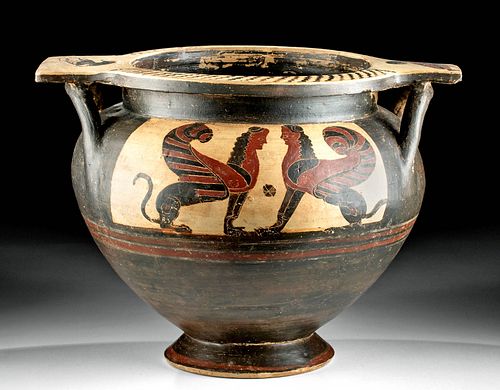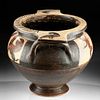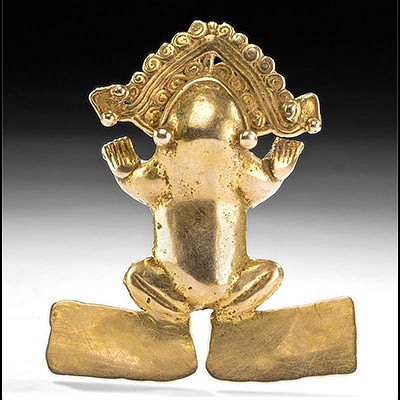Published Greek Corinthian Krater, ex-Christie's
Lot 11
About Seller
Artemis Fine Arts
686 S Taylor Ave, Ste 106
Louisville, CO 80027
United States
Selling antiquities, ancient and ethnographic art online since 1993, Artemis Gallery specializes in Classical Antiquities (Egyptian, Greek, Roman, Near Eastern), Asian, Pre-Columbian, African / Tribal / Oceanographic art. Our extensive inventory includes pottery, stone, metal, wood, glass and textil...Read more
Categories
Estimate:
$18,000 - $25,000
Absentee vs Live bid
Two ways to bid:
- Leave a max absentee bid and the platform will bid on your behalf up to your maximum bid during the live auction.
- Bid live during the auction and your bids will be submitted real-time to the auctioneer.
Bid Increments
| Price | Bid Increment |
|---|---|
| $0 | $25 |
| $300 | $50 |
| $1,000 | $100 |
| $2,000 | $250 |
| $5,000 | $500 |
| $10,000 | $1,000 |
| $20,000 | $2,500 |
| $50,000 | $5,000 |
| $100,000 | $10,000 |
| $200,000 | $20,000 |
About Auction
By Artemis Fine Arts
Aug 13, 2020
Set Reminder
2020-08-13 10:00:00
2020-08-13 10:00:00
America/New_York
Bidsquare
Bidsquare : Fine Antiquities, Ethnographic & Fine Art
https://www.bidsquare.com/auctions/artemis-gallery/fine-antiquities-ethnographic-fine-art-5415
Features classical antiquities, ancient and ethnographic art from cultures encompassing the globe. Egyptian, Greek, Roman, Etruscan, Near Eastern, Asian, Pre-Columbian, Native American, African / Tribal, Oceanic, Spanish Colonial, Russian, Fine Art, so much more! Artemis Fine Arts info@artemisfinearts.com
Features classical antiquities, ancient and ethnographic art from cultures encompassing the globe. Egyptian, Greek, Roman, Etruscan, Near Eastern, Asian, Pre-Columbian, Native American, African / Tribal, Oceanic, Spanish Colonial, Russian, Fine Art, so much more! Artemis Fine Arts info@artemisfinearts.com
- Lot Description
Ancient Greece, Corinth, Archaic Period, ca. mid-6th century BCE. A fabulous wheel-thrown pottery column krater with a discoid foot, a rotund piriform body with a rounded shoulder, a corseted neckline, an overhanging rim, and a pair of integral, tab-shaped handles with an arching handle underneath. The front of the vessel displays a trio of standing "padded dancers" presented in the black-figure technique, each holding their arms in interpretive manners and projecting their posteriors outward from beneath the lower fringe of red-painted vestments. The reverse displays a pair of seated sphinxes with curled red-and-black-striped wings, leonine-style bodies with sinuous tails, and raised heads boasting abstract anthropomorphic heads. The top of the tab handles display two abstract birds in a red-and-black color scheme, with registers of black zigzags along the top of the rim, and faint red bands course across the foot and midsection of the body. Size: 13.4" W x 9.875" H (34 cm x 25.1 cm).
The column krater, a large vessel used for mixing wine and water, gets its name from the column-like handles. It is said that the form first emerged with Corinthian examples in the late 7th century BCE. The style then gained popularity among the elites of ancient Athens, and subsequently Athenian potters created them quite regularly from the first half of the 6th century BCE until the third quarter of the 5th century BCE.
According to the Christie's auction catalog, "The three figures depicted on one side of this vase are often referred to as "padded dancers." These revelers are dressed in a costume designed to accentuate their bellies and buttocks for a specific occasion. As D.A. Amyx describes (p. 651 in 'Corinthian Vase-Painting of the Archaic Period,' vol.2), 'the nature of that occasion has been, and still is, a matter for speculation, for there is no general agreement on the answer to this question.' Some scholars speculate that the dancers are related to a Dionysian theme while others suggest that it might be a rite associated with Artemis. Despite the ambiguity, they were a popular motif on Corinthian vases from the mid 7th to the mid 6th century B.C." ("Antiquities: Monday 29 April 2019." Christie's, New York, 2019, p. 23).
For a stylistically-similar example depicting mammals and Hephaestos, please see The British Museum, 1867,0508.860: https://www.britishmuseum.org/research/collection_online/collection_object_details.aspx?objectId=399339&partId=1&people=95526&peoA=95526-2-58&sortBy=&page=1
Another stylistically-similar example, of a slightly larger size and with an avian motif, hammered for $37,500 at Christie's, New York Antiquities auction (sale 14355, April 25, 2017, lot 243): https://www.christies.com/lotfinder/ancient-art-antiquities/a-corinthian-black-figured-column-krater-late-corinthian-circa-6067612-details.aspx?from=searchresults&intObjectID=6067612&sid=2b02cca1-2c30-4b11-b7d4-13d22c5eae1f
Provenance: private Colorado, USA collection; ex-Christie's, New York Antiquities auction (sale 17459, April 29, 2019); ex-private American collection, acquired in 2018 in Los Angeles, California, USA; exhibited at the Museum of World Treasures, Wichita, Kansas, USA, 2000-2018; ex-private American collection; ex-Superior Galleries, "Fine Antiquities" auction, Beverly Hills, California, USA, lot 336; ex-Royal-Athena Galleries, New York, USA, acquired in 1989 and published in "One Thousand Years of Ancient Greek Vases from Greece, Etruria & Southern Italy," 1990, no. 13; ex-Munzen und Medaillen, Basel, Switzerland; ex-Sotheby's, New York, Antiquities auction (March 1-2, 1984, lot 47); ex-Sotheby's, London Antiquities auction (December 8, 1980, lot 231)
All items legal to buy/sell under U.S. Statute covering cultural patrimony Code 2600, CHAPTER 14, and are guaranteed to be as described or your money back.
A Certificate of Authenticity will accompany all winning bids.
We ship worldwide and handle all shipping in-house for your convenience.
#147366Repaired from multiple large pieces and re-fired during this process so a TL is not feasible. Small chips, resurfacing, light overpainting, and adhesive residue along break lines. Chips and abrasions to rim, body, handles, and foot, with fading to original pigmentation, light encrustations, and some stable hairline fissures. Nice earthen deposits and traces of original pigmentation throughout.Condition
- Shipping Info
-
All shipping is handled in-house for your convenience. Your invoice from Artemis Gallery will include shipping calculation instructions. If in doubt, please inquire BEFORE bidding for estimated shipping costs for individual items.
-
- Buyer's Premium



 EUR
EUR CAD
CAD AUD
AUD GBP
GBP MXN
MXN HKD
HKD CNY
CNY MYR
MYR SEK
SEK SGD
SGD CHF
CHF THB
THB
















